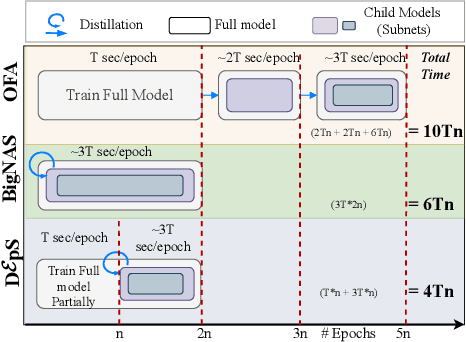Animesh Agrawal
DεpS: Delayed ε-Shrinking for Faster Once-For-All Training
Jul 08, 2024



Abstract:CNNs are increasingly deployed across different hardware, dynamic environments, and low-power embedded devices. This has led to the design and training of CNN architectures with the goal of maximizing accuracy subject to such variable deployment constraints. As the number of deployment scenarios grows, there is a need to find scalable solutions to design and train specialized CNNs. Once-for-all training has emerged as a scalable approach that jointly co-trains many models (subnets) at once with a constant training cost and finds specialized CNNs later. The scalability is achieved by training the full model and simultaneously reducing it to smaller subnets that share model weights (weight-shared shrinking). However, existing once-for-all training approaches incur huge training costs reaching 1200 GPU hours. We argue this is because they either start the process of shrinking the full model too early or too late. Hence, we propose Delayed $\epsilon$-Shrinking (D$\epsilon$pS) that starts the process of shrinking the full model when it is partially trained (~50%) which leads to training cost improvement and better in-place knowledge distillation to smaller models. The proposed approach also consists of novel heuristics that dynamically adjust subnet learning rates incrementally (E), leading to improved weight-shared knowledge distillation from larger to smaller subnets as well. As a result, DEpS outperforms state-of-the-art once-for-all training techniques across different datasets including CIFAR10/100, ImageNet-100, and ImageNet-1k on accuracy and cost. It achieves 1.83% higher ImageNet-1k top1 accuracy or the same accuracy with 1.3x reduction in FLOPs and 2.5x drop in training cost (GPU*hrs)
Understanding Pedestrian Movement Using Urban Sensing Technologies: The Promise of Audio-based Sensors
Jun 14, 2024Abstract:While various sensors have been deployed to monitor vehicular flows, sensing pedestrian movement is still nascent. Yet walking is a significant mode of travel in many cities, especially those in Europe, Africa, and Asia. Understanding pedestrian volumes and flows is essential for designing safer and more attractive pedestrian infrastructure and for controlling periodic overcrowding. This study discusses a new approach to scale up urban sensing of people with the help of novel audio-based technology. It assesses the benefits and limitations of microphone-based sensors as compared to other forms of pedestrian sensing. A large-scale dataset called ASPED is presented, which includes high-quality audio recordings along with video recordings used for labeling the pedestrian count data. The baseline analyses highlight the promise of using audio sensors for pedestrian tracking, although algorithmic and technological improvements to make the sensors practically usable continue. This study also demonstrates how the data can be leveraged to predict pedestrian trajectories. Finally, it discusses the use cases and scenarios where audio-based pedestrian sensing can support better urban and transportation planning.
SuperFed: Weight Shared Federated Learning
Jan 26, 2023Abstract:Federated Learning (FL) is a well-established technique for privacy preserving distributed training. Much attention has been given to various aspects of FL training. A growing number of applications that consume FL-trained models, however, increasingly operate under dynamically and unpredictably variable conditions, rendering a single model insufficient. We argue for training a global family of models cost efficiently in a federated fashion. Training them independently for different tradeoff points incurs $O(k)$ cost for any k architectures of interest, however. Straightforward applications of FL techniques to recent weight-shared training approaches is either infeasible or prohibitively expensive. We propose SuperFed - an architectural framework that incurs $O(1)$ cost to co-train a large family of models in a federated fashion by leveraging weight-shared learning. We achieve an order of magnitude cost savings on both communication and computation by proposing two novel training mechanisms: (a) distribution of weight-shared models to federated clients, (b) central aggregation of arbitrarily overlapping weight-shared model parameters. The combination of these mechanisms is shown to reach an order of magnitude (9.43x) reduction in computation and communication cost for training a $5*10^{18}$-sized family of models, compared to independently training as few as $k = 9$ DNNs without any accuracy loss.
 Add to Chrome
Add to Chrome Add to Firefox
Add to Firefox Add to Edge
Add to Edge